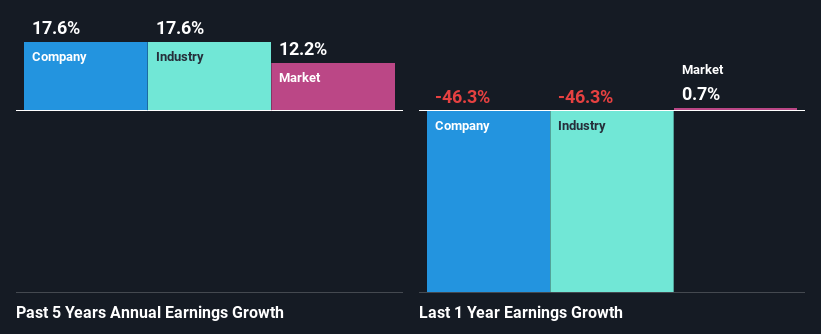Will Weakness in Dr. Martens plc's (LON:DOCS) Stock Prove Temporary Given Strong Fundamentals?
It is hard to get excited after looking at Dr. Martens' (LON:DOCS) recent performance, when its stock has declined 7.0% over the past three months. However, stock prices are usually driven by a company’s financial performance over the long term, which in this case looks quite promising. Specifically, we decided to study Dr. Martens' ROE in this article.
Return on equity or ROE is an important factor to be considered by a shareholder because it tells them how effectively their capital is being reinvested. In short, ROE shows the profit each dollar generates with respect to its shareholder investments.
Check out our latest analysis for Dr. Martens
How Is ROE Calculated?
The formula for ROE is:
Return on Equity = Net Profit (from continuing operations) ÷ Shareholders' Equity
So, based on the above formula, the ROE for Dr. Martens is:
19% = UK£69m ÷ UK£368m (Based on the trailing twelve months to March 2024).
The 'return' is the amount earned after tax over the last twelve months. That means that for every £1 worth of shareholders' equity, the company generated £0.19 in profit.
What Has ROE Got To Do With Earnings Growth?
We have already established that ROE serves as an efficient profit-generating gauge for a company's future earnings. Based on how much of its profits the company chooses to reinvest or "retain", we are then able to evaluate a company's future ability to generate profits. Assuming everything else remains unchanged, the higher the ROE and profit retention, the higher the growth rate of a company compared to companies that don't necessarily bear these characteristics.
Dr. Martens' Earnings Growth And 19% ROE
At first glance, Dr. Martens seems to have a decent ROE. And on comparing with the industry, we found that the the average industry ROE is similar at 17%. This certainly adds some context to Dr. Martens' moderate 18% net income growth seen over the past five years.
Next, on comparing Dr. Martens' net income growth with the industry, we found that the company's reported growth is similar to the industry average growth rate of 18% over the last few years.
Earnings growth is an important metric to consider when valuing a stock. It’s important for an investor to know whether the market has priced in the company's expected earnings growth (or decline). Doing so will help them establish if the stock's future looks promising or ominous. What is DOCS worth today? The intrinsic value infographic in our free research report helps visualize whether DOCS is currently mispriced by the market.
Is Dr. Martens Using Its Retained Earnings Effectively?
With a three-year median payout ratio of 35% (implying that the company retains 65% of its profits), it seems that Dr. Martens is reinvesting efficiently in a way that it sees respectable amount growth in its earnings and pays a dividend that's well covered.
Along with seeing a growth in earnings, Dr. Martens only recently started paying dividends. Its quite possible that the company was looking to impress its shareholders. Based on the latest analysts' estimates, we found that the company's future payout ratio over the next three years is expected to hold steady at 39%. Accordingly, forecasts suggest that Dr. Martens' future ROE will be 17% which is again, similar to the current ROE.
Summary
Overall, we are quite pleased with Dr. Martens' performance. Particularly, we like that the company is reinvesting heavily into its business, and at a high rate of return. Unsurprisingly, this has led to an impressive earnings growth. That being so, a study of the latest analyst forecasts show that the company is expected to see a slowdown in its future earnings growth. Are these analysts expectations based on the broad expectations for the industry, or on the company's fundamentals? Click here to be taken to our analyst's forecasts page for the company.
Have feedback on this article? Concerned about the content? Get in touch with us directly. Alternatively, email editorial-team (at) simplywallst.com.
This article by Simply Wall St is general in nature. We provide commentary based on historical data and analyst forecasts only using an unbiased methodology and our articles are not intended to be financial advice. It does not constitute a recommendation to buy or sell any stock, and does not take account of your objectives, or your financial situation. We aim to bring you long-term focused analysis driven by fundamental data. Note that our analysis may not factor in the latest price-sensitive company announcements or qualitative material. Simply Wall St has no position in any stocks mentioned.

 Yahoo Finance
Yahoo Finance 
